Optimal Design and Tests of a Pulsating Roll-Cleaning Device for Tiger Nuts
Abstract
:1. Introduction
2. Overall Design and Working Principle of the Pulsating Roll-Cleaning Device
2.1. Overall Structure
2.2. Working Principle
3. Design of Key Structures
3.1. Design of the Variable-Speed Transmission System
- Buttons on the “menu bar” can be used to invoke and save data and to calculate the gear ratio of the two gears, which is displayed in the “area to display changes in the instantaneous gear ratio curves”.
- The “animation display area” intuitively shows pitch curves of the designed elliptical gears. The diagrams also change in real time when adjusting the parameters of the elliptical gears, thus fully exhibiting the human–computer interaction function.
- The “function control area” can control the start and pause of gear meshing and also achieve adjustment of the movement steps.
- The “parameter adjustment area” can adjust the parameters, including the length of the semi-major axis, length of the semi-minor axis, number of teeth, gear ratio, and deformation coefficient of the elliptical gears. Through adjusting these parameters, elliptical gears with different orders, gear ratios, and eccentricities can be obtained (Figure 5).
- The “area to display changes in the instantaneous gear ratio curves” can, in real time, show changes to the gear ratio, lending convenience to the computational process.
- The “important data display area” can accurately display key parameters, including the gear ratio, number of teeth, module, and center-to-center spacing directly as digits, which facilitates a comparative analysis.
- The “area to display the progress of the optimization goal” can intuitively exhibit whether the designed elliptical gears meet the design requirement or not. The parameters are regarded as satisfying the design requirement when all progress bars are red. As long as one progress bar is black, the parameters do not meet the design requirements and should be adjusted until they do.
3.2. Design of Circular Screen Holes
3.3. Design of the Settlement and Collection Tank
4. Simulation of the Working Process of the Cleaning Device Based on RecurDyn 2023-EDEM 2022 Coupling
4.1. Establishment of the Distinct Element Model of Tiger Nut Aggregates
4.2. Single-Factor Simulation Tests
4.2.1. Test Schemes and Results
- Influence of the rate of rotation of the brush roller on the cleaning effect
- 2.
- Influence of the order of elliptical gears on the cleansing effect
- 3.
- Influence of the eccentricity of elliptical gears on the cleansing effect
4.2.2. Analysis of the Simulation Test Results
5. Bench Tests for Performance Optimization
5.1. Test Conditions
5.2. Test Indices
5.3. Box–Behnken Design Using Response Surface Methodology
5.4. Establishment of Regression Models and Significance Analysis
5.5. Parameter Optimization
5.6. Test Verification
6. Discussion
- Environmental influence:
- 2.
- Random distribution of attitudes of tiger nuts mixed with impurities:
- 3.
- Entanglement of soil and fibrous roots:
7. Conclusions
- By adjusting the number of teeth, gear ratio, and deformation coefficient of the elliptical gears and other parameters through the analysis software for the meshing transmission of pitch curves of the elliptical gears with arbitrary orders, the elliptical gear satisfying the transmission stability is obtained, and the pulse variable speed transmission of the brush roller is realized, which ensures the increase in the cleaning efficiency and reduces the breakage rate of tiger nuts.
- The RecurDyn 2023-EDEM 2022 coupling simulations were used to clarify the influence of key factors on the number of collisions, the number of bonds, and the total stress of tiger nuts during the cleaning process. The optimal ranges of the various parameters of the cleaning device are ascertained as follows: the rate of rotation of the brush roller is 260~300 rpm, the order of the elliptical gears is 1~3, and the eccentricity of the elliptical gears is 0.1~0.15.
- The results of the bench performance test show that the rate of rotation of the brush roller has the greatest influence on the cleaning efficiency, breakage rate, and impurity rate. Meanwhile, the optimal operation parameters of the cleaning device are as follows: when the rate of rotation of the brush roller is 280 rpm, the order of the elliptical gears is 2, and the eccentricity of the elliptical gears is 0.122; the cleaning efficiency, breakage rate, and impurity rate are, separately, 1.83 t·h−1, 0.15%, and 0.16%. The cleaning effect is favorable under these conditions, meeting the design requirements of the cleaning device.
Author Contributions
Funding
Institutional Review Board Statement
Data Availability Statement
Acknowledgments
Conflicts of Interest
References
- Li, P.; Dai, Y.Y.; Wang, W.W. Analysis on the evolution of trade competitiveness of China’s main edible oil products. Cereals Oils 2019, 32, 5–9. [Google Scholar]
- Yang, X.D.; Li, Z.Y. Tigernut industry in China: Current status of development, potential and adaptive suggestions. Chin. J. Oil Crop Sci. 2022, 44, 712–717. [Google Scholar]
- Zhang, H.M.; Zhou, Z.; Qu, Z.; Li, Z.J.; Wang, W.Z. Simulation and experiment of sieving process of sieving device for tiger nut harvester. Agriculture 2022, 12, 2–16. [Google Scholar] [CrossRef]
- Qi, J.T.; Gao, J.P.; Chen, S.; Chen, W.H.; Yang, L.Y.; Meng, H.W.; Kan, Z. Parameter optimization of a conveying and separating device based on a five-stage screw and vibrating screen for tiger nut harvesters. Agriculture 2024, 14, 2–25. [Google Scholar] [CrossRef]
- Wang, X.Y.; Sun, J.B.; Xu, Y.C.; Li, X.Q.; Cheng, P.F. Design and experiment of potato cleaning and sorting machine. Trans. Chin. Soc. Agric. Mach. 2017, 48, 316–322. [Google Scholar]
- Ji, L.L.; Yang, H.G.; Xie, H.X.; Yan, J.C.; Wei, H.; Shen, H.Y. Experimental study on potato dry cleaning device. J. Agric. Mech. Res. 2022, 44, 153–161. [Google Scholar]
- Yan, M.L.; Shi, W.H.; Zhou, X.L.; Zhang, Z.D.; Zhang, Y.; Wu, C.L. Research on industry security of China’s main oilseeds and vegetable oils from the perspective of import. Chin. J. Oil Crop Sci. 2023, 45, 643–653. [Google Scholar] [CrossRef]
- Branko, V.; Urban, Š. Invasion, distribution and habitat affiliation of Cyperus esculentus, a new weed in Slovenia. Hacquetia 2021, 20, 291–302. [Google Scholar]
- Ekow, E.A.; Joshua, A.; Nazir, H.K. Drying kinetics and quality of whole, halved, and pulverized tiger nut tubers. Int. J. Food Sci. 2021, 2021, 8870001. [Google Scholar]
- Avicor, S.W.; Wajidi, M.F.F.; Achoribo, E.S.; Ong, M.T.; Hamzah, S.N. Tiger nut (Cyperus esculentus) as a potential phytoinsecticide: Larvicidal activity of crude extracts on Aedes aegypti and Culex quinquefasciatus (Diptera: Culicidae). Trop. Biomed. 2021, 38, 186–191. [Google Scholar]
- Gadanya, A.M.; Abubakar, M.Y.; Maigari, F.U.; Mudassir, L.; Abubakar, S.M. Comparative analysis of nutrients content and characterization of oil from two varieties of tiger nut (Cyperus esculentus). Asian J. Res. Biochem. 2021, 8, 11–21. [Google Scholar] [CrossRef]
- Qi, J.T.; Pei, M.H.; Kan, Z.; Meng, H.W. Parameter optimization and testing of a conveying and soil-removing device for tiger nut (Cyperus esculentus) mechanical harvesting. Processes 2022, 11, 67. [Google Scholar] [CrossRef]
- Zhao, Y.Q.; Li, B.J.; Meng, L.; Wang, L.; Bi, T.; Jian, J.M.; Hou, S.L. Optimal design of mechanical harvesting and separation system for tiger nut. J. Agric. Mech. Res. 2022, 44, 51–56. [Google Scholar] [CrossRef]
- Zhang, H.M.; Zhou, Z.; Lv, Z.J.; Wang, W.Z.; He, H.; Lv, Y.L. Kinematic analysis and testing of vibratory sieving mechanism for Cyperus esculentus L. harvester. J. Chin. Agric. Mech. 2021, 42, 92–99. [Google Scholar] [CrossRef]
- Liu, W.L.; Kong, L.Y.; Jiang, C.Y.; Wang, X.Y.; Zhang, L. Design of tiger nut grain harvester. Agric. Dev. Equip. 2019, 10, 111–112. [Google Scholar]
- Wu, X.T.; Wang, G.H. Non-Circular Gear and Non-Uniform Transmission; China Machine Press: Beijing, China, 1997. [Google Scholar]
- Li, F.S.; Yin, Z.F.; Zhang, Z.L.; Lin, Z.G.; Zhang, Z.D.; Li, H.Y. Non-Circular Gear and Special Gear Transmission Design; China Machine Press: Beijing, China, 1983. [Google Scholar]
- Chen, H. Simulation analysis in dedusting deposition chamber of the engineering sweeper based on FLUENT. Equip. Manuf. Technol. 2019, 68–71. [Google Scholar]
- Wang, Y.X.; Huang, S.T.; Zhang, W.Y.; Qi, B.; Zhou, X.Z.; Ding, Y.Q. Design and experiment of wheat precision seed metering device with staggered hook-tooth. Trans. Chin. Soc. Agric. Mach. 2024, 55, 142–154. [Google Scholar]
- Chen, Y.; Gao, X.X.; Jin, X.; Ma, X.R.; Hu, B.; Zhang, X.L. Calibration and analysis of seeding parameters of Cyperus esculentus seeds based on discrete element simulation. Trans. Chin. Soc. Agric. Mach. 2023, 54, 58–69. [Google Scholar]
- Xu, H.B.; Zhang, P.; Zhang, Y.H.; Wang, S.Y.; Yu, Z.Y.; Gu, F.W. Design and experiment of peanut pod-picking and conveying device of multistage tangential flow type peanut combine. Trans. Chin. Soc. Agric. Mach. 2023, 54, 52–60. [Google Scholar]
- Zhang, H.M.; Zhang, C.M.; Li, Z.J.; Ding, L.; Zhu, C.H.; Zhang, J. Simulation analysis and optimization of vibration characteristics of corn finger clip seeding device based on EDEM–RecurDyn Coupling. Trans. Chin. Soc. Agric. Mach. 2023, 54, 36–46. [Google Scholar]
- Yuan, P.P.; Li, H.W.; Huang, S.H.; Jiang, S.; Xu, J.; Lin, H.; Li, R.R. Parameter optimization and experiment of a seed furrow cleaning device for no-till maize seeding. Agriculture 2022, 12, 2–17. [Google Scholar] [CrossRef]
- Zhang, X.J.; Cheng, J.P.; Shi, Z.L.; Wang, M.J.; Fu, H.; Wu, H.F. Simulation and experiment of seed taking performance of swing-clamp type maize precision seed-metering device. Trans. Chin. Soc. Agric. Mach. 2023, 54, 38–50. [Google Scholar]
- Zhang, S.W.; Zhang, R.Y.; Cao, Q.Q.; Zhang, Y.; Fu, J.; Yuan, H.F. Design and experiment of double-deck roller sieve type fruit impurity separation device for tiger nut harvester. Trans. Chin. Soc. Agric. Mach. 2023, 54, 148–157. [Google Scholar]
- Hu, J.P.; Pan, J.; Chen, F.; Yue, R.C.; Yao, M.J.; Li, J. Simulation optimization and experiment of finger-clamping seedling picking claw based on EDEM–RecurDyn. Trans. Chin. Soc. Agric. Mach. 2022, 53, 75–85. [Google Scholar]
- Wang, F.A.; Wen, B.; Xie, X.H.; Xie, K.T.; Guo, S.W.; Zhang, Z.G. Operation mechanism analysis and parameter optimization of conveying and separating device of panax notoginseng harvester. Trans. Chin. Soc. Agric. Mach. 2023, 54, 201–211. [Google Scholar]
- Zhang, S.W.; Zhang, R.Y.; Chen, T.Y.; Fu, J.; Yuan, H.F. Calibration of simulation parameters of mung bean seeds using discrete element method and verification of seed-metering test. Trans. Chin. Soc. Agric. Mach. 2022, 53, 71–79. [Google Scholar]
- He, X.N.; Zhang, X.J.; Zhao, Z.; Shang, S.Q.; Wang, D.W.; Yuan, X.W. Design and test of resistance-reducing excavation device of cyperus edulis based on discrete element method. Trans. Chin. Soc. Agric. Mach. 2022, 53, 71–79. [Google Scholar]
- Yan, B.X.; Wu, G.W.; Fu, W.Q.; Gao, N.N.; Meng, Z.J.; Zhu, P. Influencing factors of corn implantation distribution for high-height planting based on EDEM. Trans. Chin. Soc. Agric. Mach. 2020, 51, 47–54. [Google Scholar]
- Wei, Z.C.; Su, G.L.; Li, X.Q.; Wang, F.M.; Sun, C.Z.; Meng, P.X. Parameter optimization and test of potato harvester wavy sieve based on EDEM. Trans. Chin. Soc. Agric. Mach. 2020, 51, 109–122. [Google Scholar]
- Liao, Y.T.; Liao, Q.X.; Zhou, Y.; Wang, Z.T.; Jiang, Y.J.; Liang, F. Parameters calibration of discrete element model of fodder rape crop harvest in bolting stage. Trans. Chin. Soc. Agric. Mach. 2020, 51, 73–82. [Google Scholar]
- Wang, X.Z.; Yue, B.; Gao, X.J.; Zheng, Z.Q.; Zhu, R.X.; Huang, Y.X. Discrete element simulations and experiments of disturbance behavior as affected by mounting height of subsoiler’s Wing. Trans. Chin. Soc. Agric. Mach. 2018, 49, 124–136. [Google Scholar]
- Liu, W.Z.; He, J.; Li, H.W.; Li, X.Q.; Zheng, K.; Wei, Z.C. Calibration of simulation parameters for potato minituber based on EDEM. Trans. Chin. Soc. Agric. Mach. 2018, 49, 125–135, 142. [Google Scholar]
- QHYS02-2017; Enterprise Standard for 5QPZ Series of Cleaning and Polishing Machine of Tiger Nut Tubers. Jilin Haoyishou Agricultural Science and Technology Development Co., Ltd.: Changchun, China, 2017.
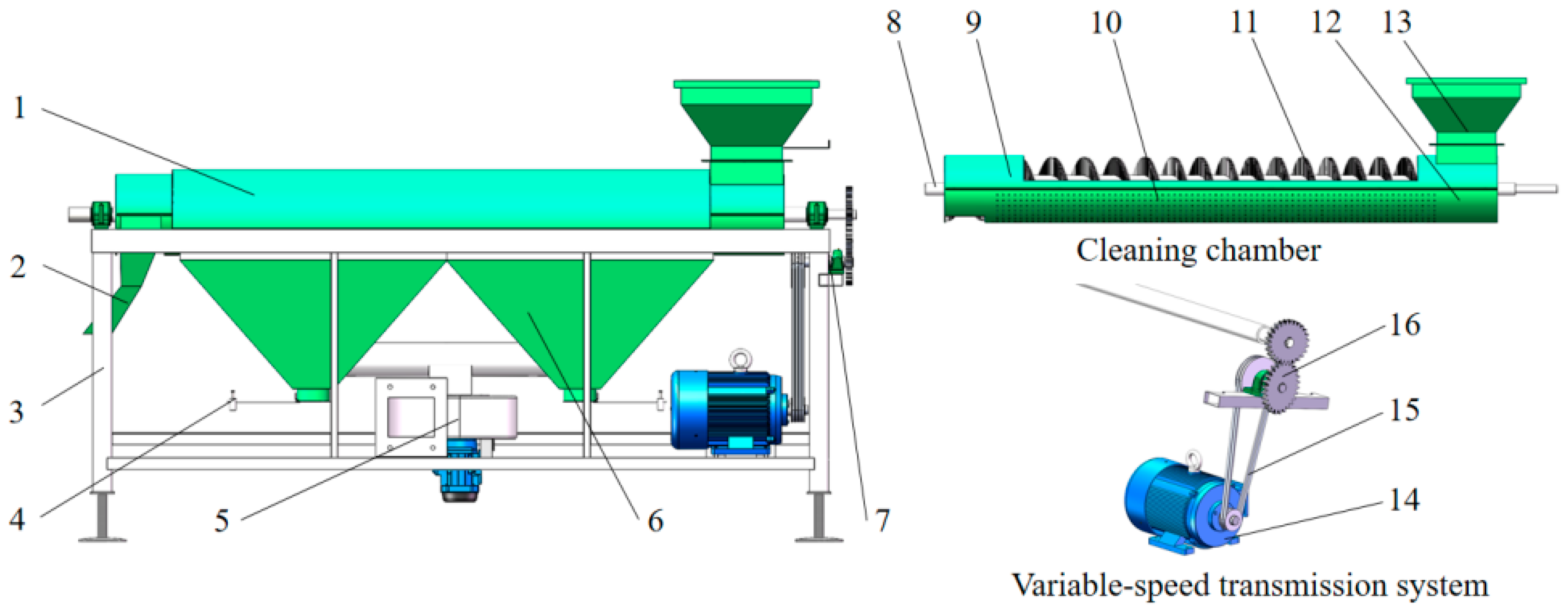
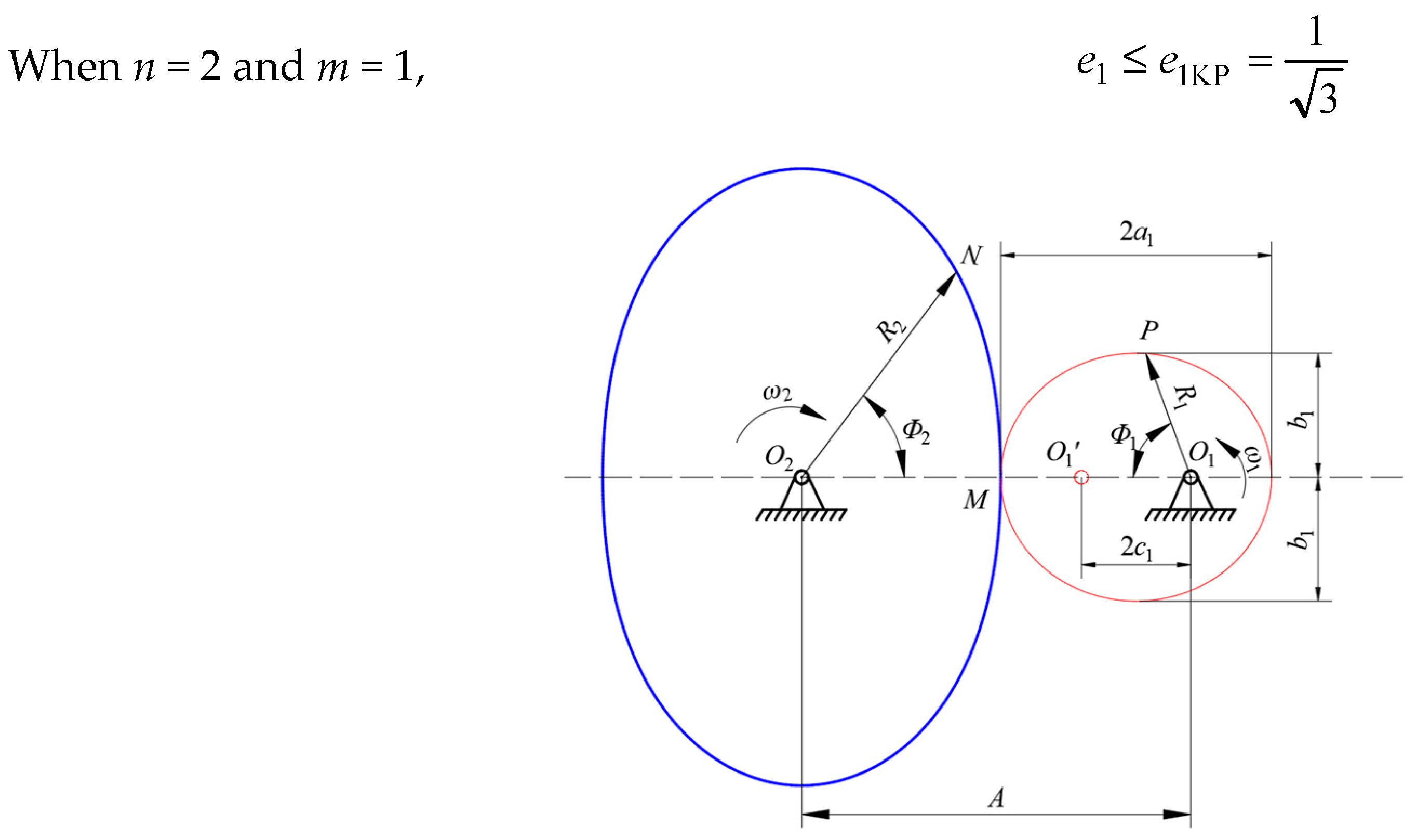
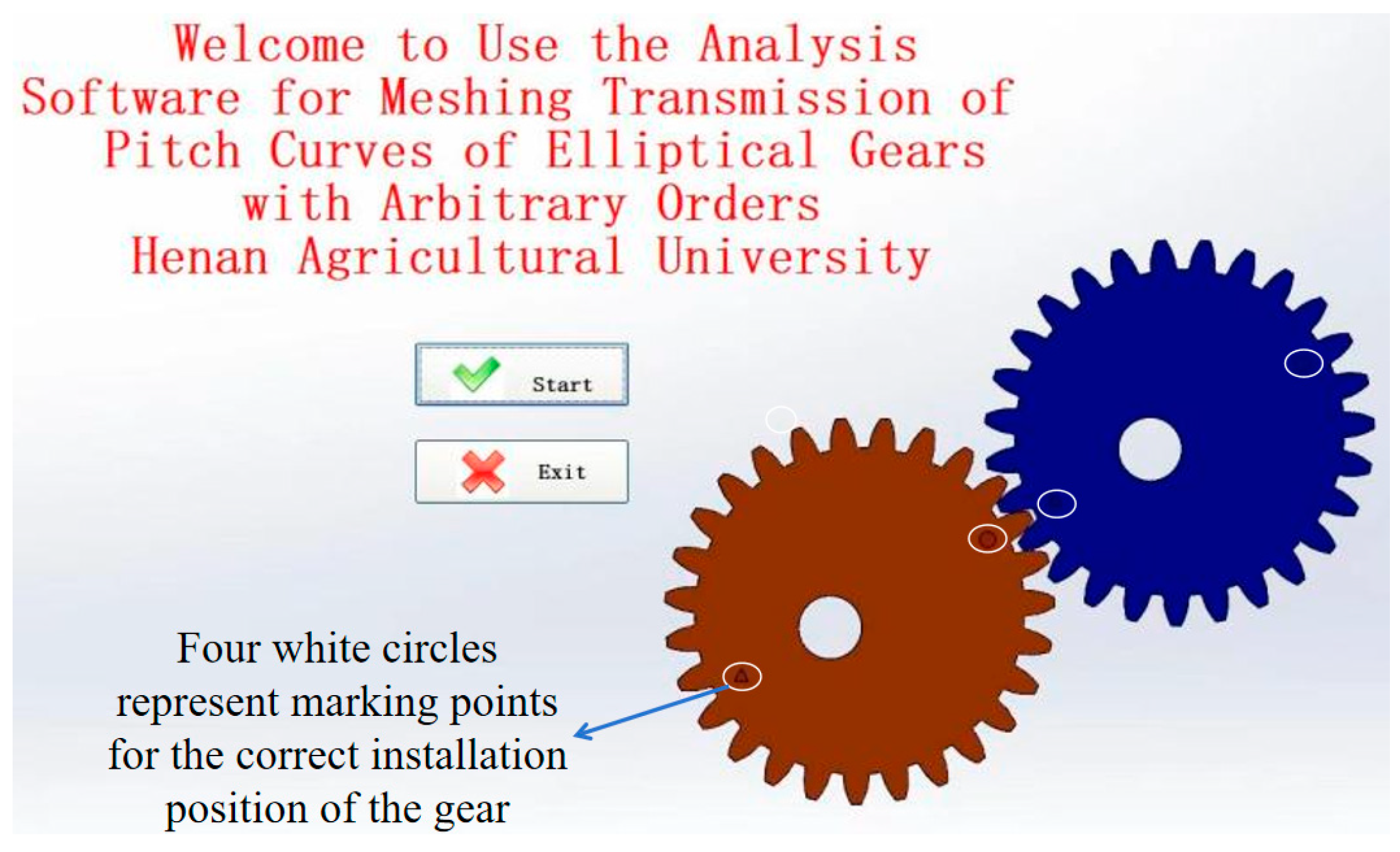
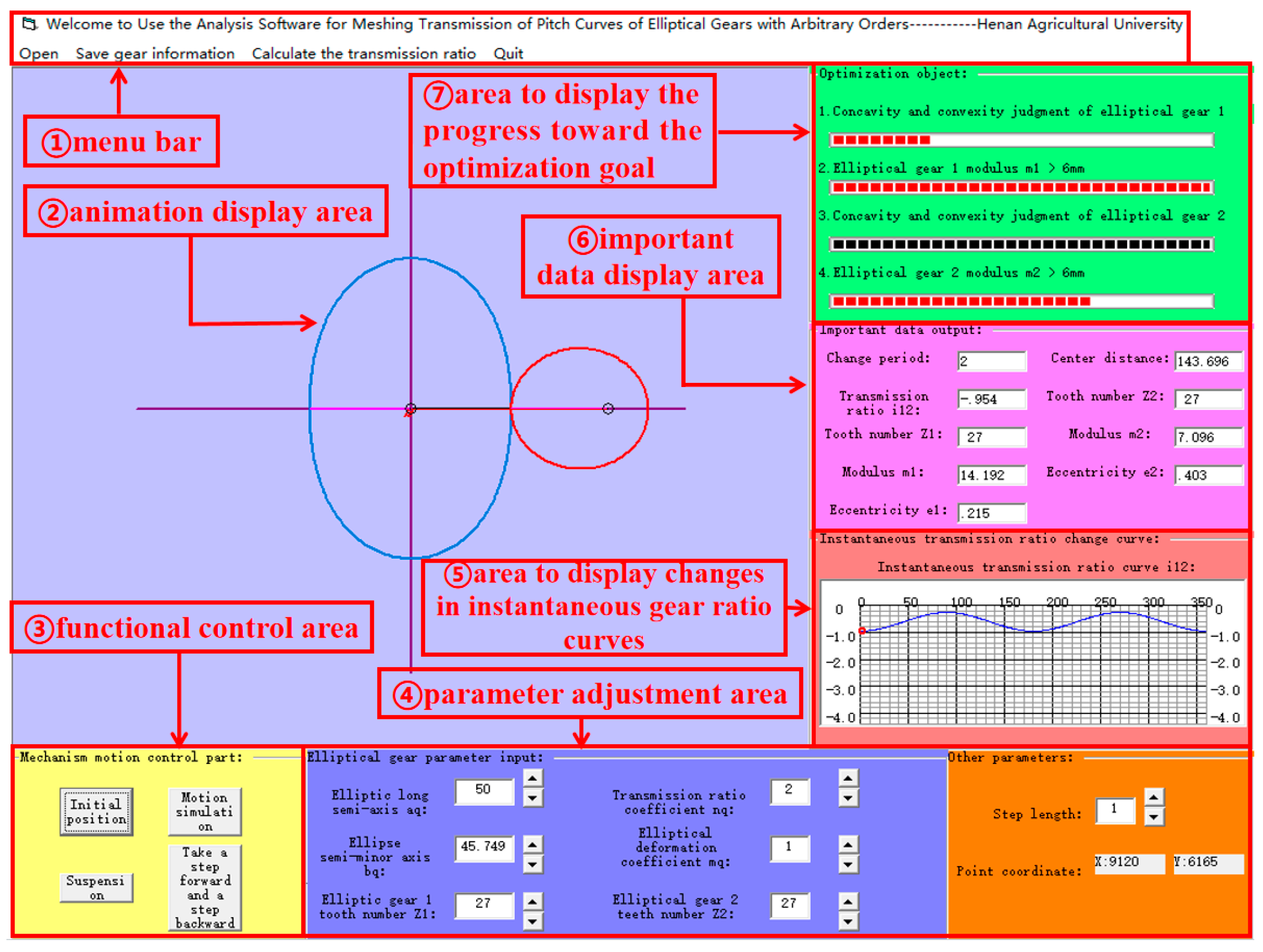
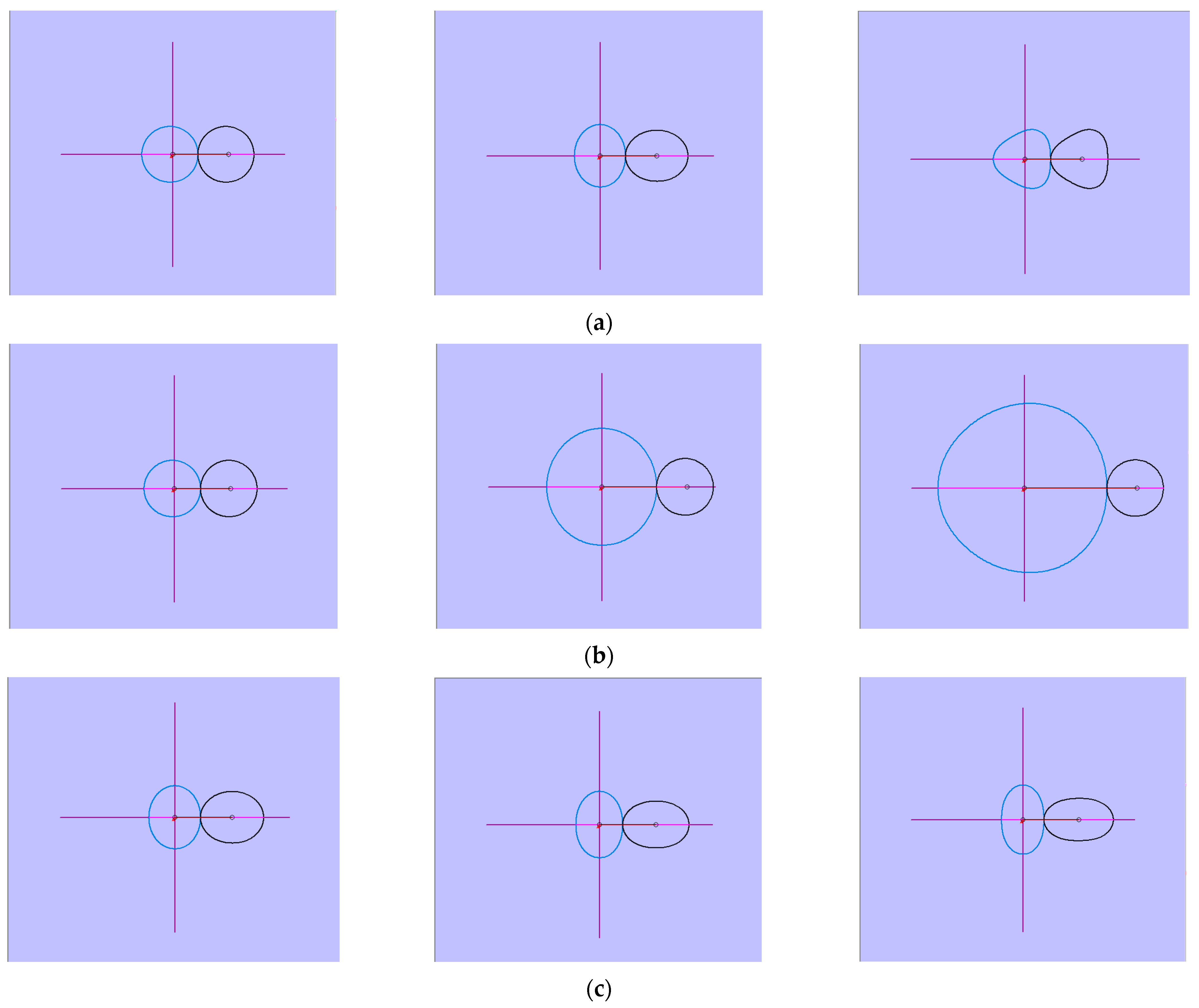



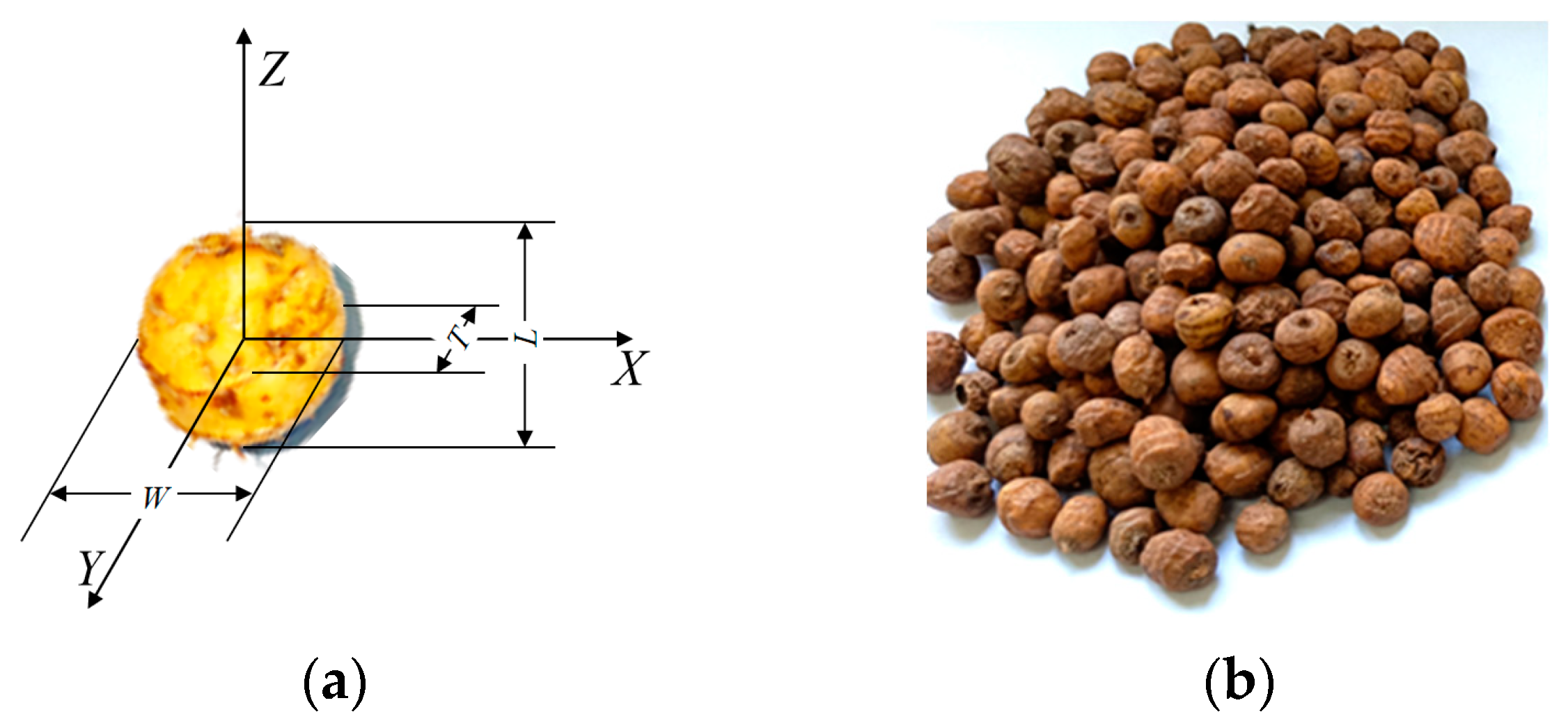
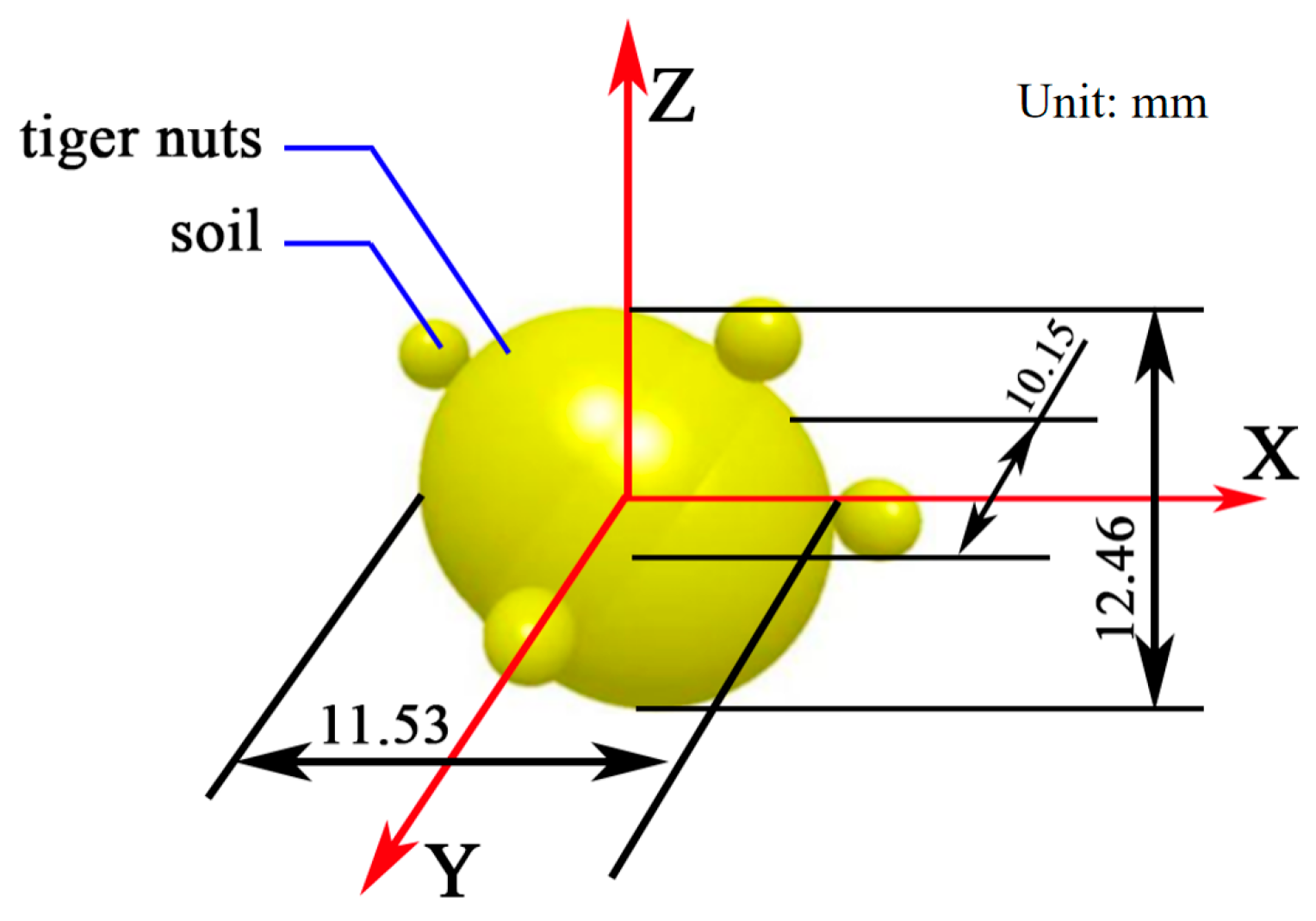
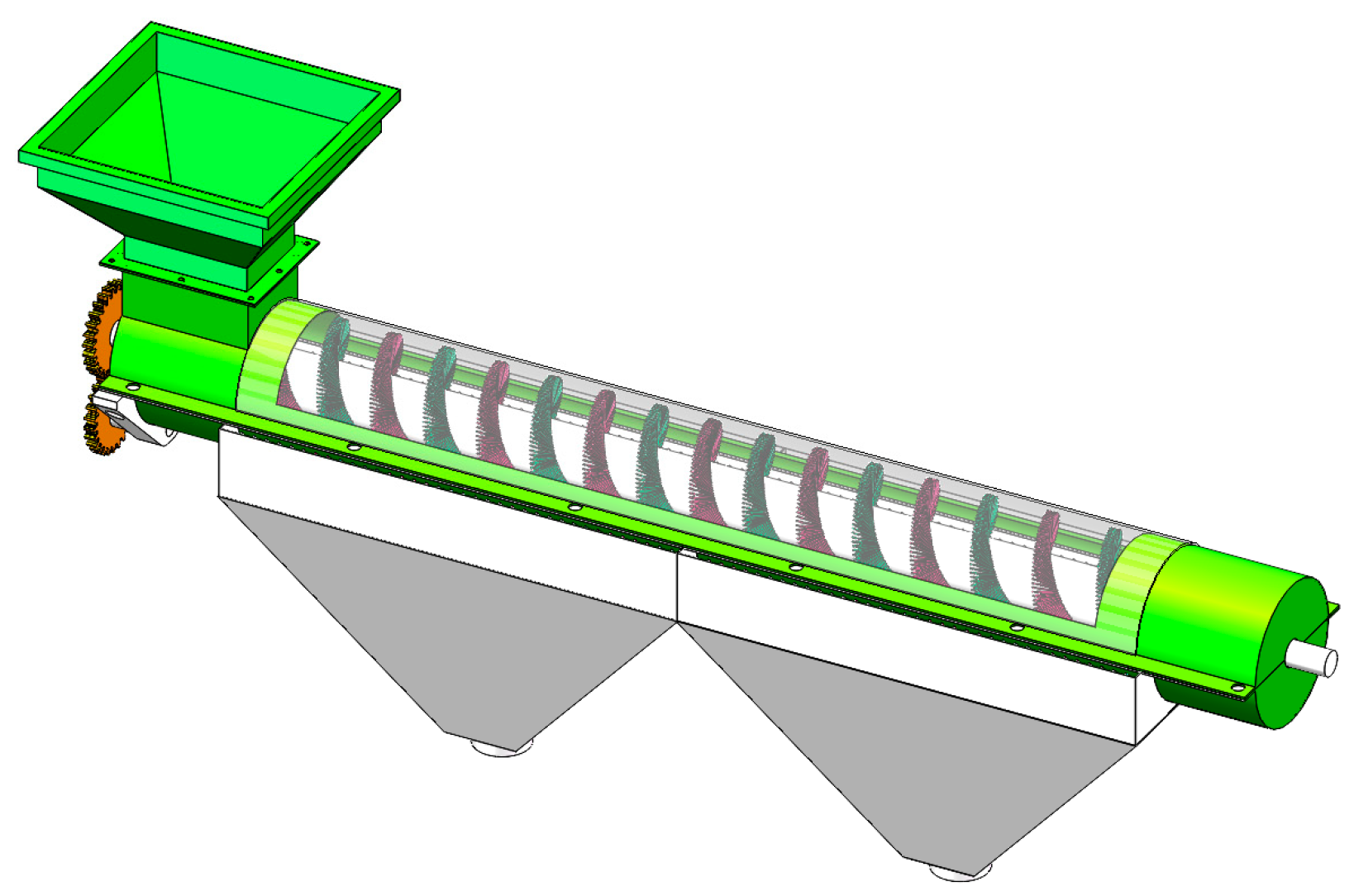
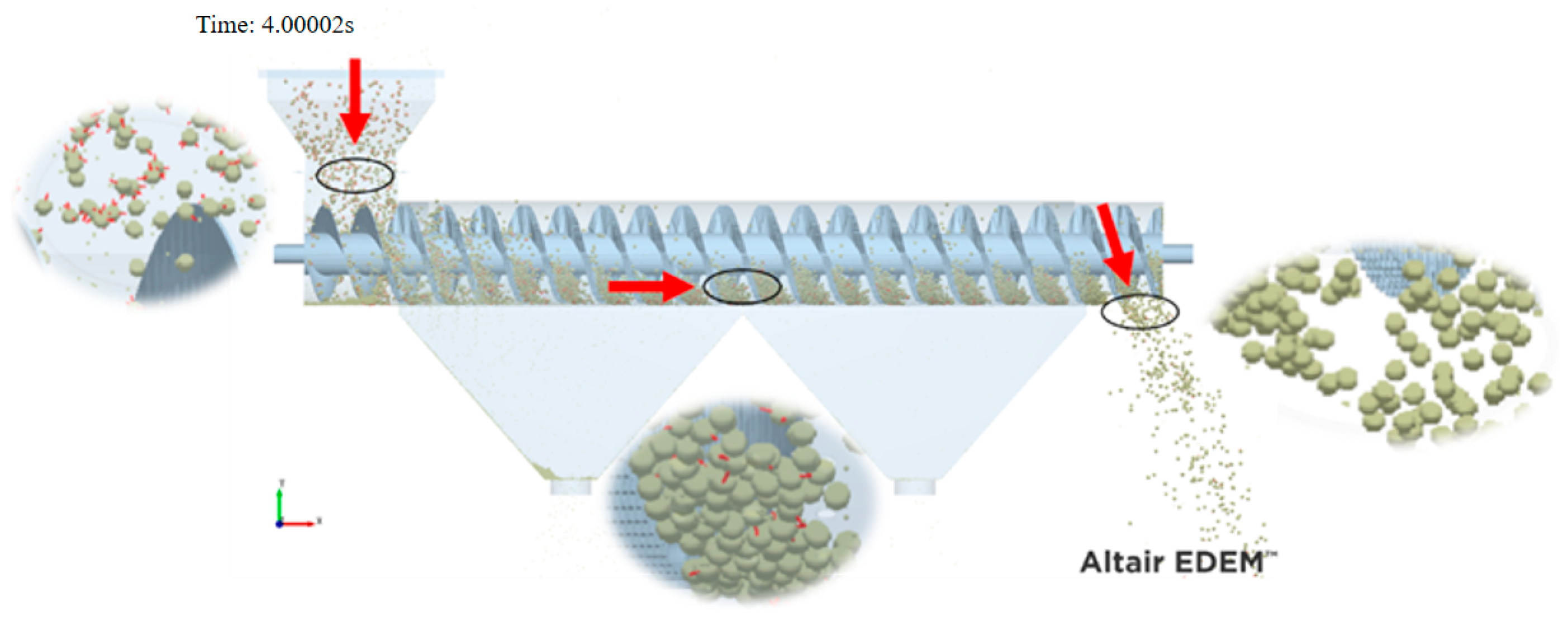

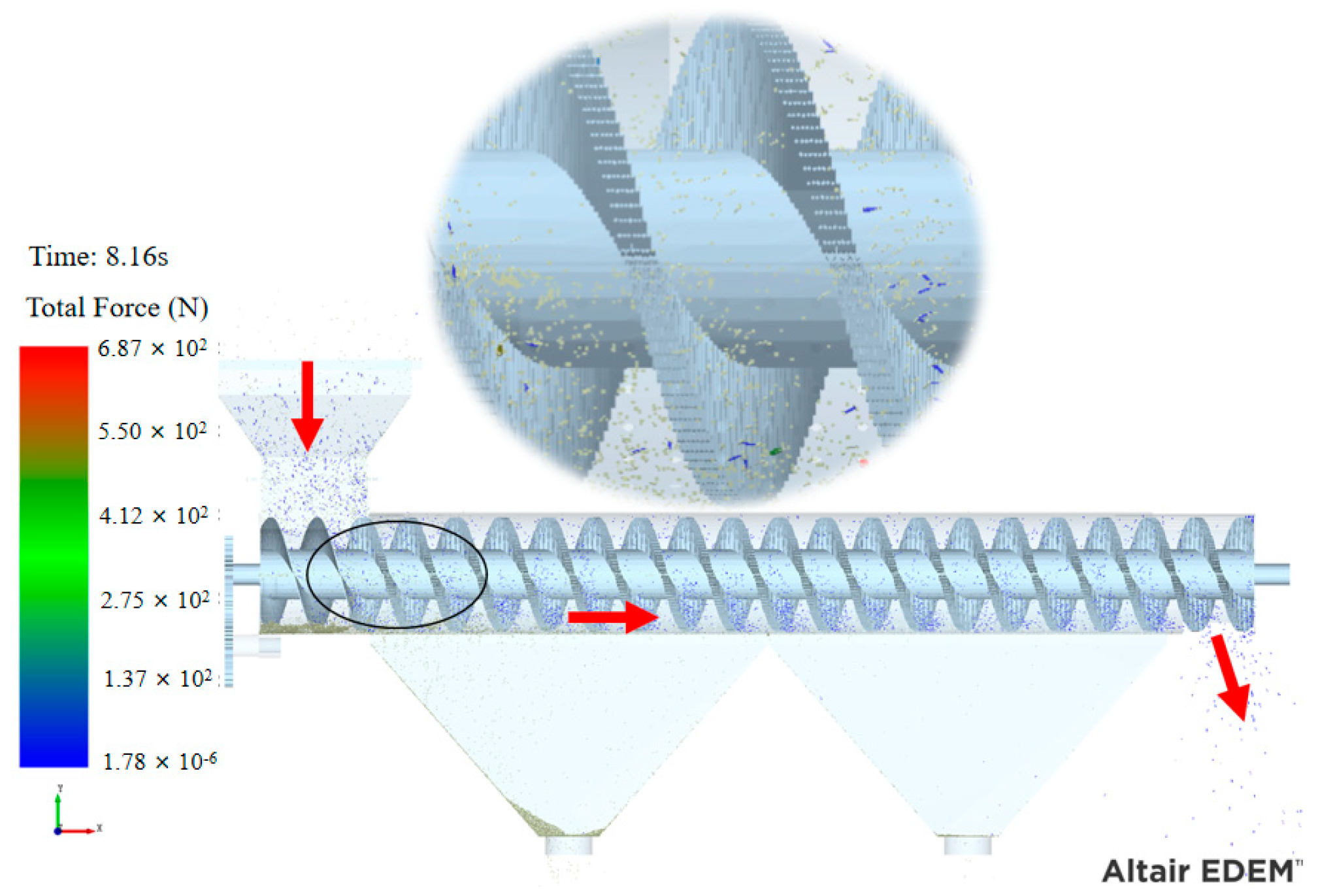
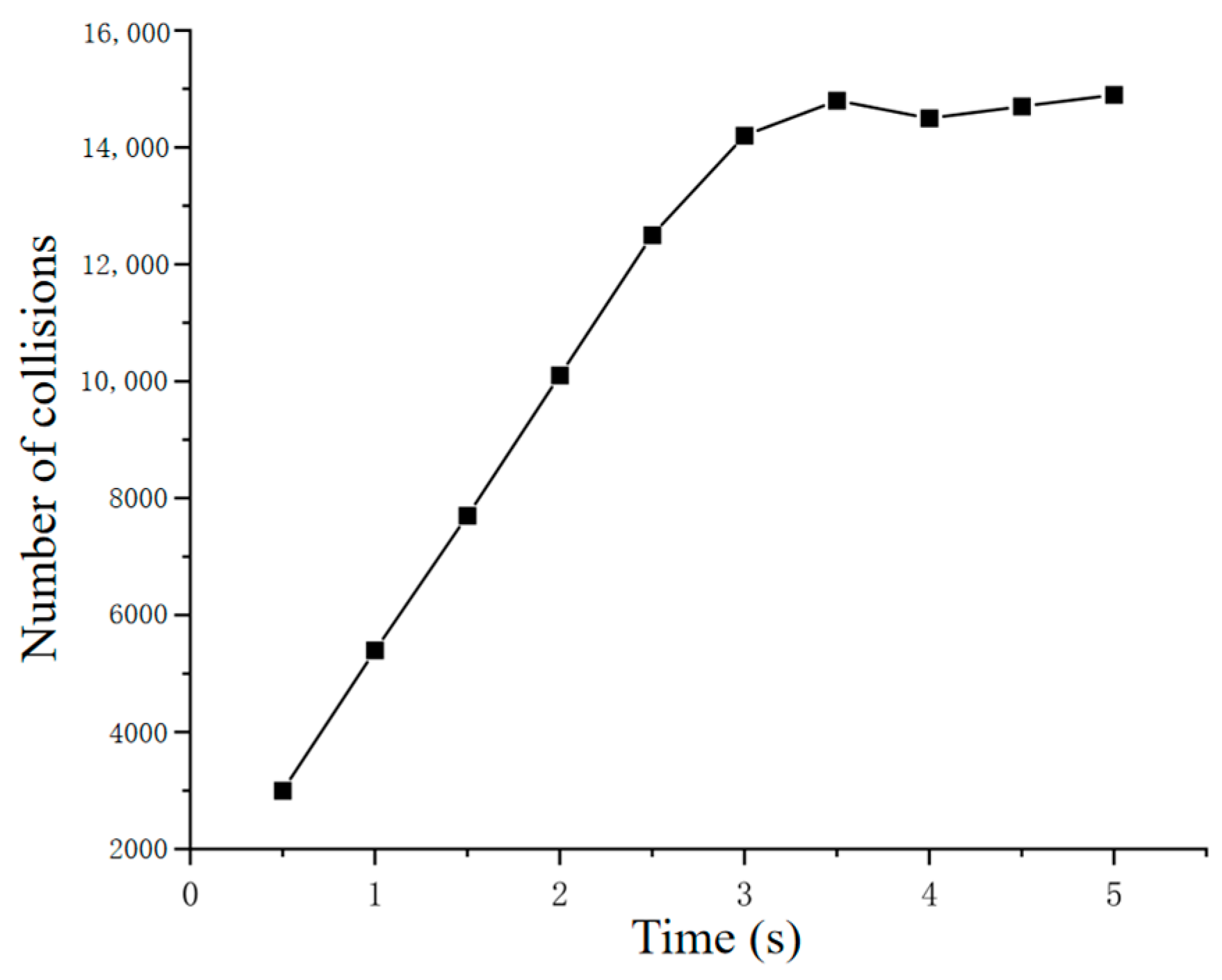

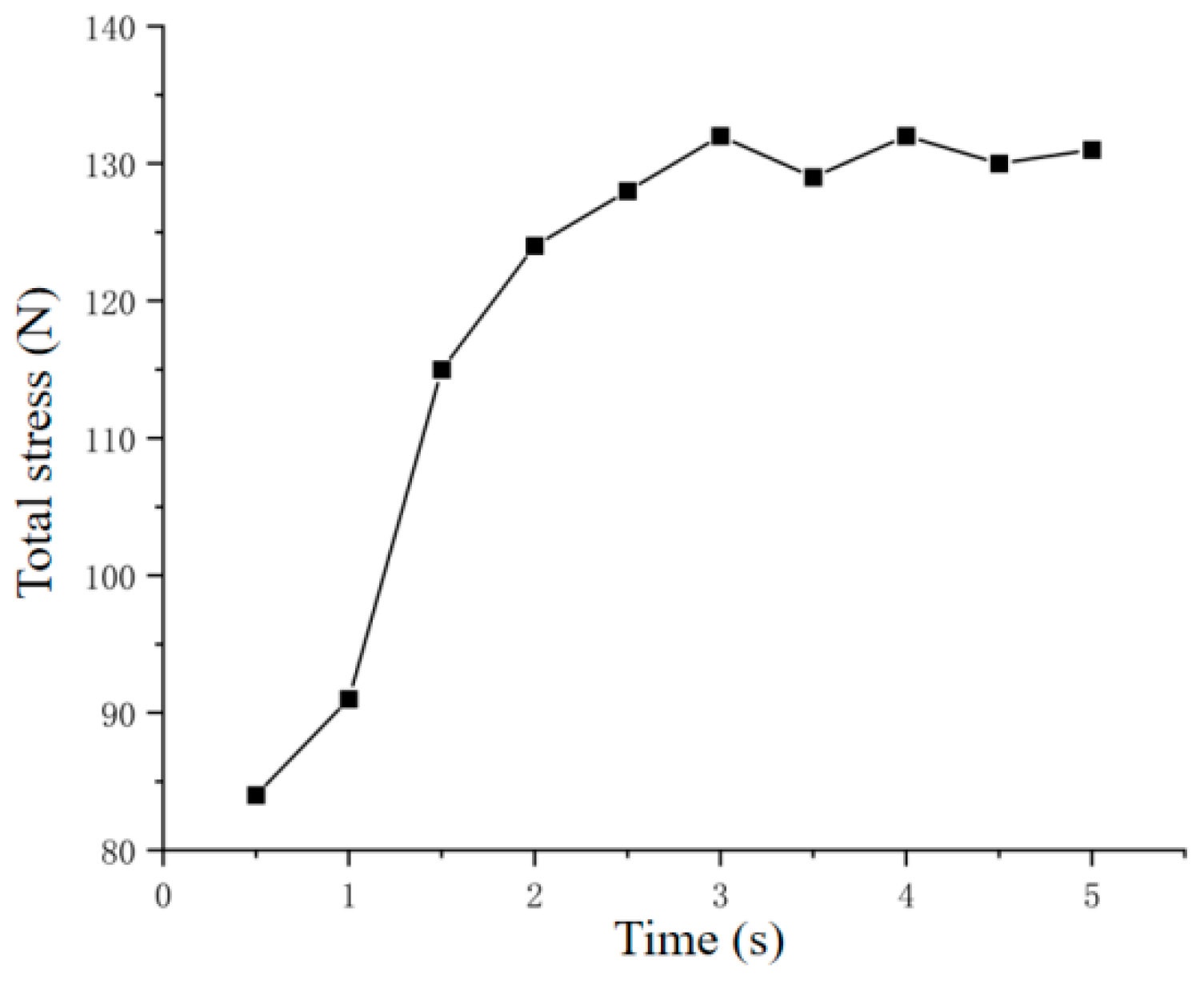


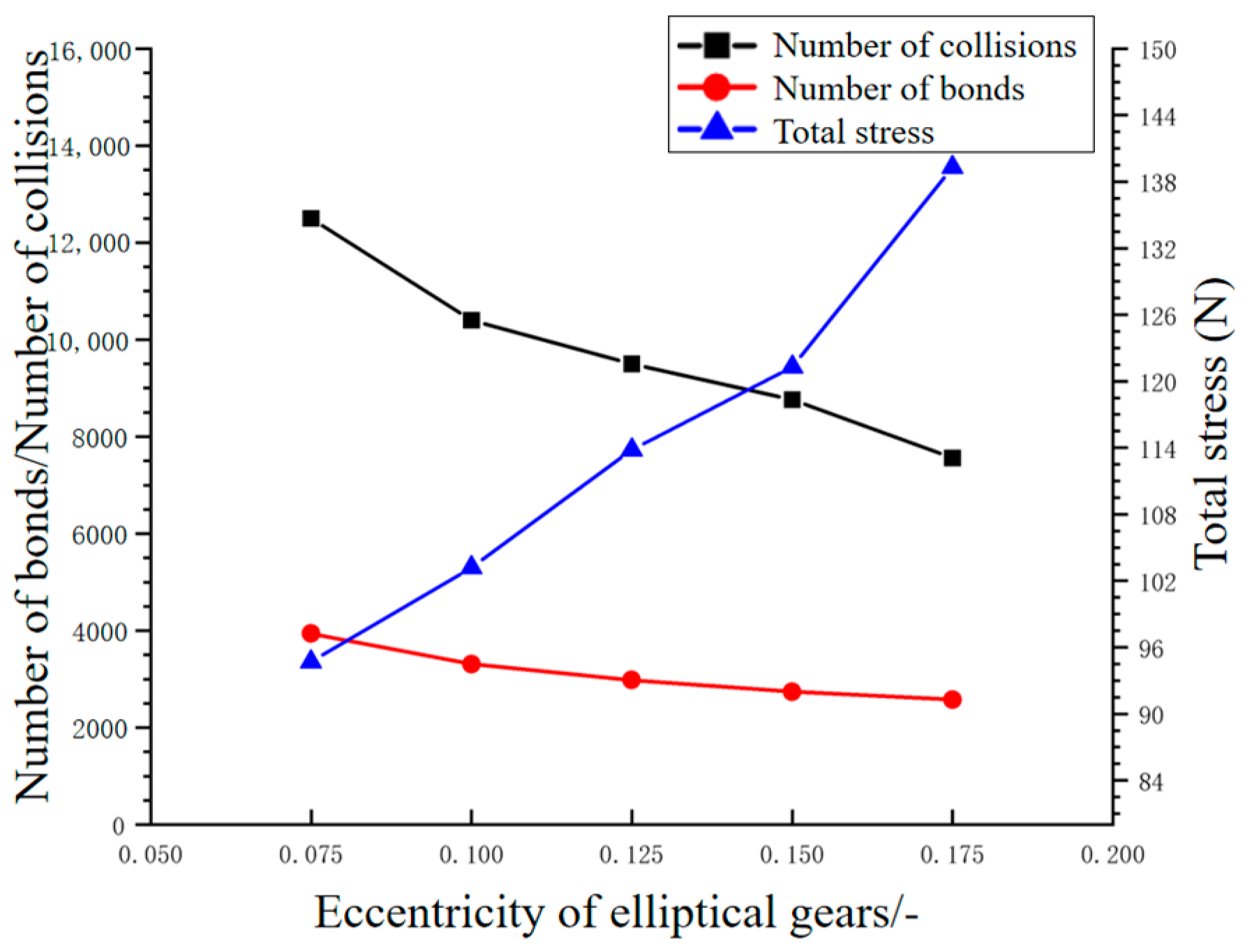
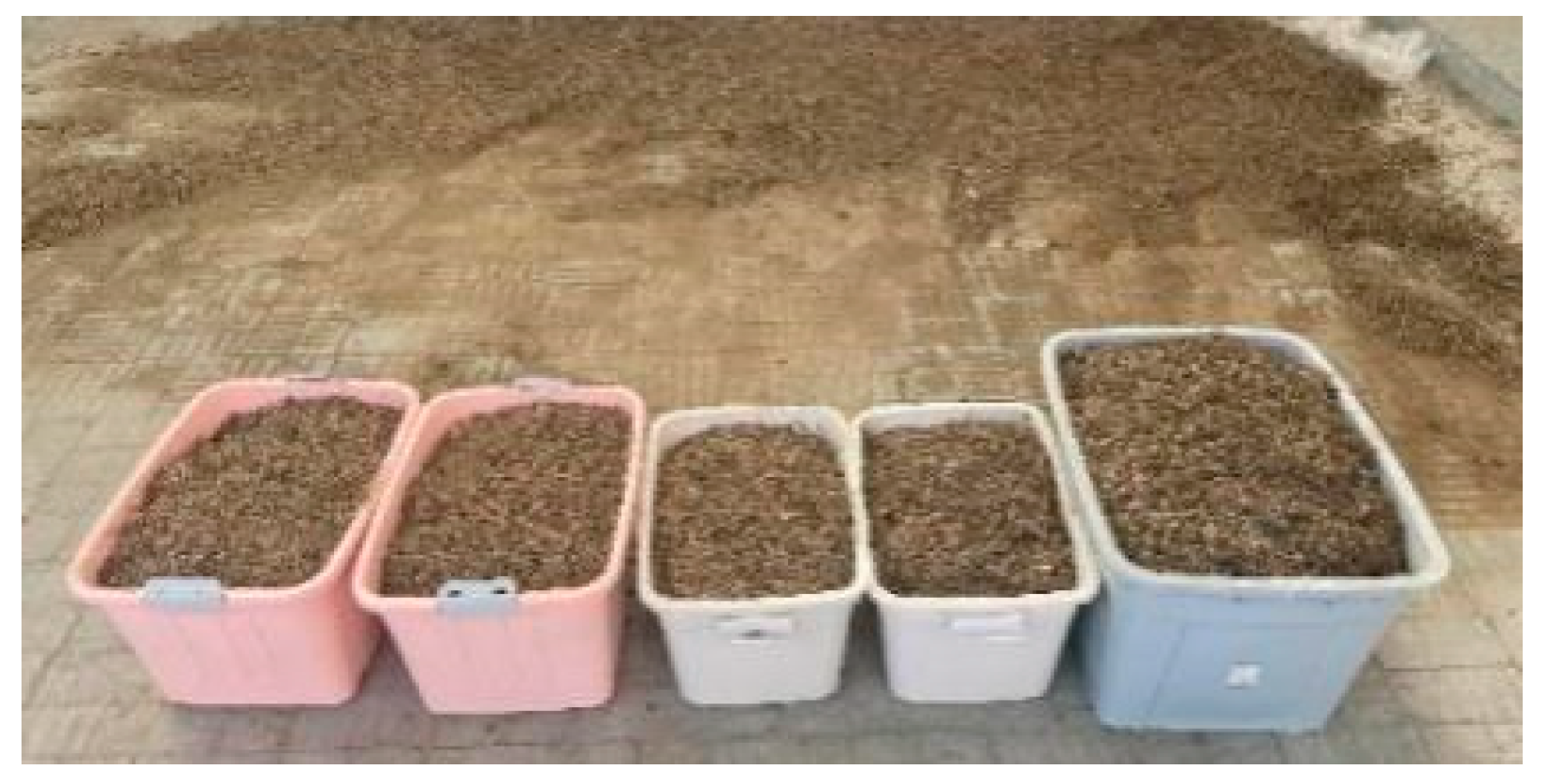
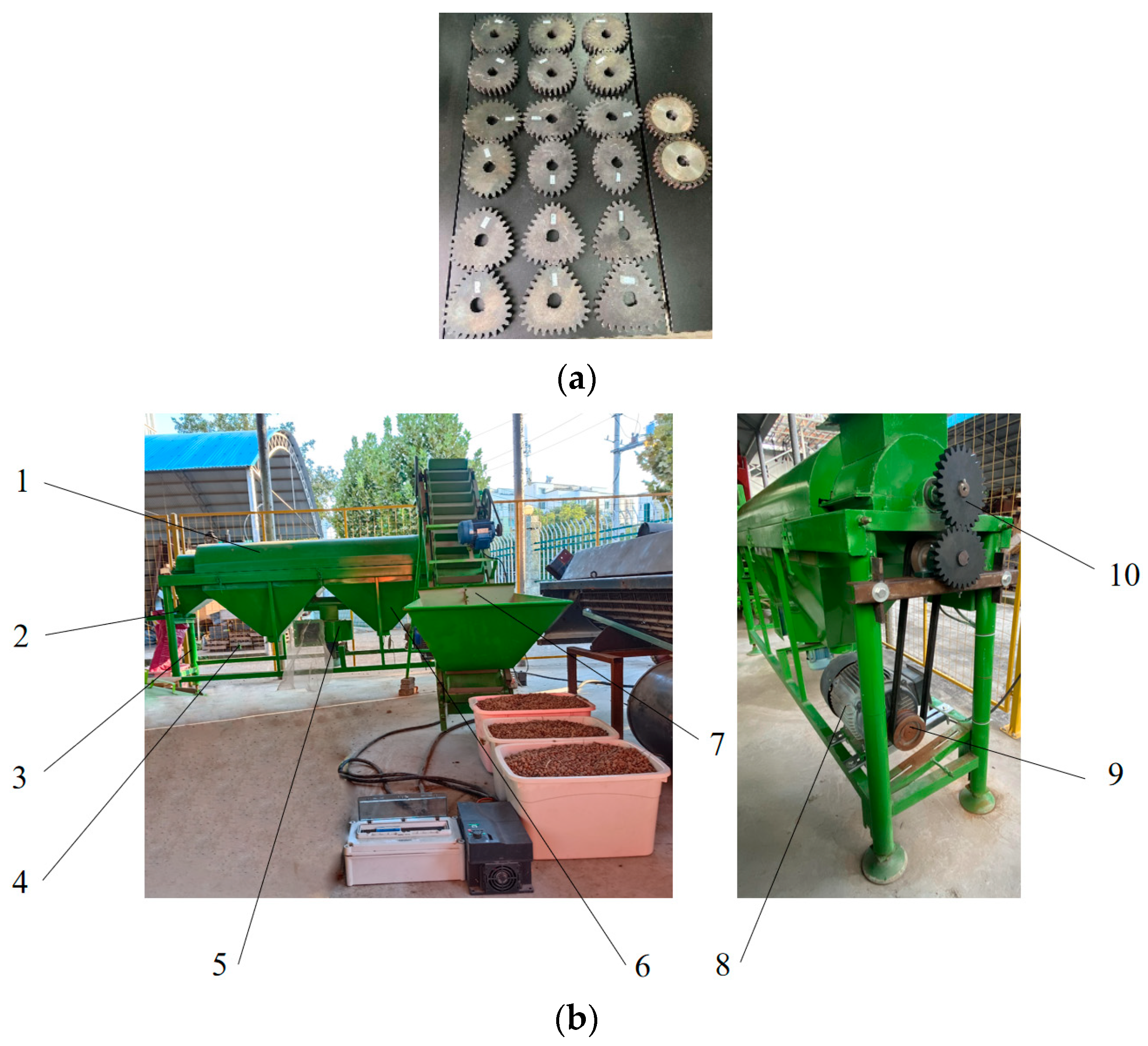



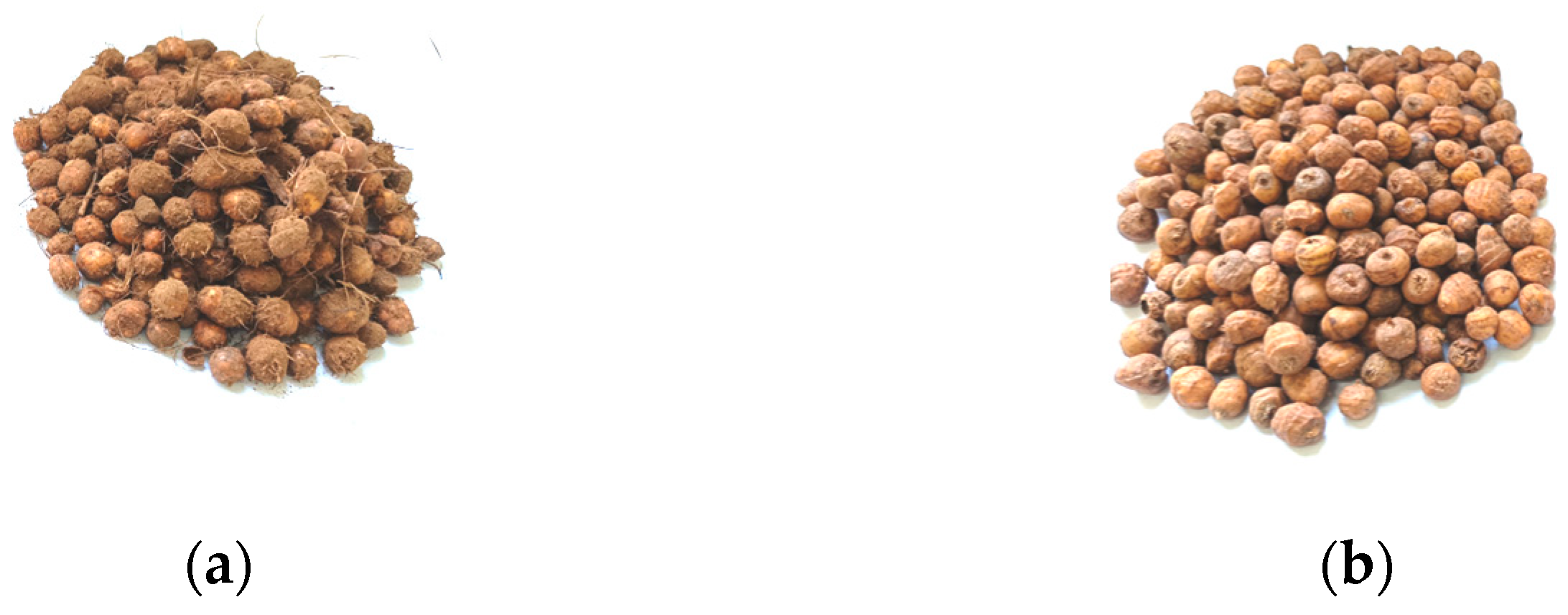
| Key Technical Parameter | Value | Unit |
|---|---|---|
| Length | 3000 | mm |
| Width | 600 | mm |
| Height | 1970 | mm |
| Diameter of brush roller | 320 | mm |
| Motor power | 7.5 | kW |
| Power of impurity removal blower | 1.5 | kW |
| Simulation Parameter | Value |
|---|---|
| Tiger nut density | 1102 kg·m−3 |
| Soil density | 1780 kg·m−3 |
| Material density of the brush | 1760 kg·m−3 |
| Steel density | 7801 kg·m−3 |
| Poisson’s ratio of tiger nuts | 0.360 |
| Poisson’s ratio of the soil | 0.260 |
| Poisson’s ratio of the brush | 0.400 |
| Poisson’s ratio of steel | 0.290 |
| Shear modulus of tiger nuts | 3.09 × 107 Pa |
| Shear modulus of the soil | 2.77 × 106 Pa |
| Shear modulus of the brush | 1.02 × 108 Pa |
| Shear modulus of steel | 8.02 × 1010 Pa |
| Coefficient of restitution for collisions between tiger nuts | 0.437 |
| Coefficient of rolling friction between tiger nuts | 0.268 |
| Static friction coefficient between tiger nuts | 0.780 |
| Coefficient of restitution for collisions between soil particles | 0.140 |
| Coefficient of rolling friction between soil particles | 0.270 |
| Static friction coefficient between soil particles | 0.560 |
| Coefficient of restitution for collisions between tiger nuts and soil particles | 0.260 |
| Coefficient of rolling friction between tiger nuts and soil particles | 0.320 |
| Static friction coefficient between tiger nuts and soil particles | 0.500 |
| Coefficient of restitution for collisions between tiger nuts and steel plates | 0.624 |
| Coefficient of rolling friction between tiger nuts and steel plates | 0.195 |
| Static friction coefficient between tiger nuts and steel plates | 0.420 |
| Coefficient of restitution for collisions between tiger nuts and the brush | 0.360 |
| Coefficient of rolling friction between tiger nuts and the brush | 0.180 |
| Static friction coefficient between tiger nuts and the brush | 0.410 |
| Coefficient of restitution for collisions between soil and steel plates | 0.150 |
| Coefficient of rolling friction between soil and steel plates | 0.360 |
| Static friction coefficient between soil and steel plates | 0.500 |
| Coefficient of restitution for collisions between soil and the brush | 0.010 |
| Coefficient of rolling friction between soil and the brush | 0.120 |
| Static friction coefficient between soil and the brush | 0.190 |
| Group | Rate of Rotation of Brush Roller A/rpm | Order of Elliptical Gears B/- | Eccentricity of Elliptical Gears C/- |
|---|---|---|---|
| −1 | 260 | 1 | 0.100 |
| 0 | 280 | 2 | 0.125 |
| 1 | 300 | 3 | 0.150 |
| Serial Number | Test Factors | Test Indices | ||||
|---|---|---|---|---|---|---|
| A | B | C | Cleaning Efficiency Q (t·h−1) | Breakage Rate ηp % | Impurity Rate ηz % | |
| 1 | 280.00 | 3.00 | 0.150 | 1.82 | 0.24 | 0.40 |
| 2 | 260.00 | 1.00 | 0.125 | 1.61 | 0.21 | 0.29 |
| 3 | 280.00 | 2.00 | 0.125 | 1.83 | 0.17 | 0.17 |
| 4 | 300.00 | 3.00 | 0.125 | 1.58 | 0.30 | 0.39 |
| 5 | 280.00 | 2.00 | 0.125 | 1.84 | 0.17 | 0.16 |
| 6 | 280.00 | 1.00 | 0.150 | 1.77 | 0.19 | 0.34 |
| 7 | 260.00 | 3.00 | 0.125 | 1.62 | 0.22 | 0.33 |
| 8 | 300.00 | 2.00 | 0.100 | 1.57 | 0.30 | 0.31 |
| 9 | 280.00 | 2.00 | 0.125 | 1.84 | 0.16 | 0.17 |
| 10 | 280.00 | 2.00 | 0.125 | 1.85 | 0.16 | 0.19 |
| 11 | 300.00 | 2.00 | 0.150 | 1.53 | 0.28 | 0.42 |
| 12 | 300.00 | 1.00 | 0.125 | 1.55 | 0.28 | 0.35 |
| 13 | 260.00 | 2.00 | 0.100 | 1.59 | 0.22 | 0.27 |
| 14 | 280.00 | 3.00 | 0.100 | 1.82 | 0.21 | 0.30 |
| 15 | 280.00 | 1.00 | 0.100 | 1.79 | 0.21 | 0.31 |
| 16 | 260.00 | 2.00 | 0.150 | 1.63 | 0.23 | 0.30 |
| 17 | 280.00 | 2.00 | 0.125 | 1.80 | 0.15 | 0.19 |
| Source of Variation | Cleaning Efficiency Q | Breakage Rate ηp | Impurity Rate ηz | |||
|---|---|---|---|---|---|---|
| F | p | F | p | F | p | |
| Model | 105.60 | <0.0001 | 69.23 | <0.0001 | 83.85 | <0.0001 |
| A | 23.79 | 0.0018 | 159.53 | <0.0001 | 65.65 | <0.0001 |
| B | 7.08 | 0.0324 | 13.02 | 0.0086 | 14.15 | 0.0071 |
| C | 0.20 | 0.6708 | 0.000 | 1.0000 | 61.04 | 0.0001 |
| AB | 0.39 | 0.5505 | 0.41 | 0.5438 | 0.000 | 1.0000 |
| AC | 6.29 | 0.0405 | 3.66 | 0.0972 | 10.72 | 0.0136 |
| BC | 0.39 | 0.5505 | 10.17 | 0.0153 | 8.21 | 0.0242 |
| A2 | 883.56 | <0.0001 | 314.62 | <0.0001 | 161.84 | <0.0001 |
| B2 | 2.00 | 0.1998 | 35.48 | 0.0006 | 219.66 | <0.0001 |
| C2 | 7.30 | 0.0305 | 52.78 | 0.0002 | 151.33 | <0.0001 |
| Lack-of-fit term | 0.27 | 0.8445 | 0.71 | 0.5927 | 0.60 | 0.6473 |
| Times of Tests | Cleaning Efficiency Q t·h−1 | Breakage Rate ηp % | Impurity Rate ηz % |
|---|---|---|---|
| 1 | 1.85 | 0.16 | 0.18 |
| 2 | 1.83 | 0.15 | 0.16 |
| 3 | 1.82 | 0.13 | 0.14 |
| Average | 1.83 | 0.15 | 0.16 |
Disclaimer/Publisher’s Note: The statements, opinions and data contained in all publications are solely those of the individual author(s) and contributor(s) and not of MDPI and/or the editor(s). MDPI and/or the editor(s) disclaim responsibility for any injury to people or property resulting from any ideas, methods, instructions or products referred to in the content. |
© 2024 by the authors. Licensee MDPI, Basel, Switzerland. This article is an open access article distributed under the terms and conditions of the Creative Commons Attribution (CC BY) license (https://creativecommons.org/licenses/by/4.0/).
Share and Cite
Lv, Z.; Wang, W.; Yang, D.; He, X.; Qu, Z.; Jing, W.; Mei, Y.; Huang, H.; Su, B.; Zhuang, Y. Optimal Design and Tests of a Pulsating Roll-Cleaning Device for Tiger Nuts. Agriculture 2024, 14, 1673. https://doi.org/10.3390/agriculture14101673
Lv Z, Wang W, Yang D, He X, Qu Z, Jing W, Mei Y, Huang H, Su B, Zhuang Y. Optimal Design and Tests of a Pulsating Roll-Cleaning Device for Tiger Nuts. Agriculture. 2024; 14(10):1673. https://doi.org/10.3390/agriculture14101673
Chicago/Turabian StyleLv, Zhijun, Wanzhang Wang, Dekun Yang, Xun He, Zhe Qu, Wenzhuo Jing, Yong Mei, Huinan Huang, Baohao Su, and Yangfan Zhuang. 2024. "Optimal Design and Tests of a Pulsating Roll-Cleaning Device for Tiger Nuts" Agriculture 14, no. 10: 1673. https://doi.org/10.3390/agriculture14101673






